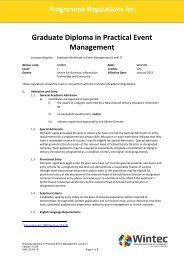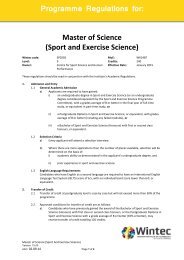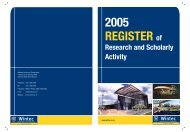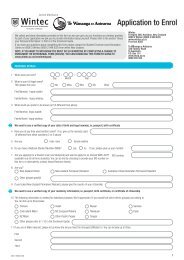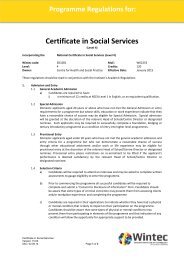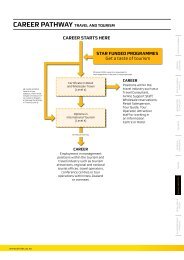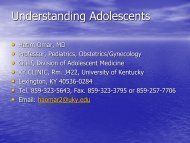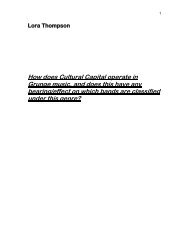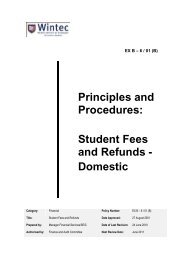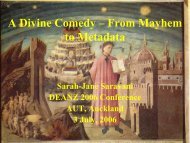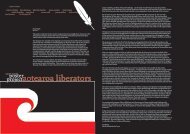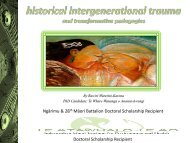Wintec Annual Report 2009
Wintec Annual Report 2009
Wintec Annual Report 2009
Create successful ePaper yourself
Turn your PDF publications into a flip-book with our unique Google optimized e-Paper software.
FINANCIAL PERFORMANCE<br />
NOTES TO THE FINANCIAL STATEMENTS (CONT)<br />
FOR THE YEAR ENDED 31 DECEMBER <strong>2009</strong><br />
e) Investment properties<br />
Properties leased to third parties under operating<br />
leases are classified as investment property<br />
unless the property is held to meet service delivery<br />
objectives, rather than to earn rentals or for capital<br />
appreciation. Property held to meet service delivery<br />
objectives is classified as property, plant,<br />
and equipment.<br />
An investment property is initially measured at its<br />
cost including transaction cost. Where an investment<br />
property is acquired at no cost or nominal cost, its<br />
cost is deemed to be its fair value as at the date<br />
of acquisition.<br />
Subsequent to initial recognition investment<br />
properties are stated at fair value as at each balance<br />
sheet date.<br />
Gains or losses arising from changes in the fair<br />
values of investment properties are recognised in<br />
the surplus or deficit.<br />
Investment properties are de-recognised when<br />
they have either been disposed of or when the<br />
investment property is permanently withdrawn<br />
from use and no future benefit is expected from<br />
its disposal.<br />
Any gains or losses on de-recognition of an<br />
investment property are recognised in the surplus<br />
or deficit.<br />
f) Intangible assets<br />
Computer Software<br />
Acquired computer software licenses are capitalised<br />
on the basis of the costs incurred to acquire and<br />
bring to use the specific software.<br />
Costs that are directly associated with the<br />
development of software for internal use, are<br />
recognised as an intangible asset. Direct costs<br />
include the software development employee<br />
costs and an appropriate portion of relevant<br />
overheads. After initial recognition, separately<br />
acquired intangible assets are carried at cost<br />
less accumulated amortisation and accumulated<br />
impairment losses.<br />
A summary of the policies applied to the Institute’s<br />
intangible assets is as follows:<br />
COMPUTER SOFTWARE<br />
Useful Lives<br />
Method Used<br />
Internally Generated/Acquired<br />
METHOD<br />
Finite - 5 years<br />
Straight Line Method<br />
Separately Acquired<br />
Amortisation<br />
The amortisation period and amortisation method for<br />
each class of intangible asset having a finite life is<br />
reviewed at each financial year-end. If the expected<br />
useful life or expected pattern of consumption is<br />
different from the previous assessment, changes are<br />
made accordingly. The carrying value of an intangible<br />
asset with a finite life is amortised on a straight-line<br />
basis over its useful life.<br />
Intangible assets that have an indefinite useful<br />
life, or not yet available for use, are not subject to<br />
amortisation and are tested annually for impairment.<br />
Assets that have a finite useful life are reviewed<br />
for indicators of impairment at each balance date.<br />
When there is an indicator of impairment the asset’s<br />
recoverable amount is estimated. An impairment<br />
loss is recognised for the amount by which the<br />
asset’s carrying amount exceeds its recoverable<br />
amount. The recoverable amount is the higher of an<br />
asset’s fair value less costs to sell and value in use.<br />
Gains or losses arising from de-recognition of an<br />
intangible asset are measured as the difference<br />
between the net disposal proceeds and the carrying<br />
amount of the asset and are recognised in the<br />
comprehensive income statement when the asset is<br />
de-recognised.<br />
Staff training costs are recognised as an expense<br />
when incurred. Costs associated with maintaining<br />
computer software are recognised as an expense<br />
when incurred.<br />
Course Development Costs<br />
Course Development costs are recognised as an<br />
expense in the Statement of Financial Performance<br />
in the year in which they are incurred.<br />
Research Cost<br />
Research costs are recognised as an expense<br />
in the surplus or deficit in the year in which they<br />
are incurred.<br />
g) Inventories<br />
Inventories are valued at the lower of cost and net<br />
realisable value. Inventories held for distribution or<br />
consumption in the provision of services that are<br />
not supplied on a commercial basis are measured<br />
at cost (using the FIFO method), adjusted when<br />
applicable, for any loss of service potential. Where<br />
inventories are acquired at no cost or for nominal<br />
consideration, the cost is the current replacement<br />
cost at the date of acquisition.<br />
Costs incurred in bringing each product to its<br />
present location and condition are accounted for<br />
as follows:<br />
Inventories held for resale-purchase cost on a firstin,<br />
first-out basis;<br />
Materials and consumables to be utilised for<br />
rendering of services- purchase cost on a first-in ,<br />
first-out basis.<br />
Net realisable value is the estimated selling price in<br />
the ordinary course of activities less the estimated<br />
costs necessary to make the sale.<br />
<strong>Wintec</strong> <strong>Annual</strong> <strong>Report</strong> <strong>2009</strong> _ 43



